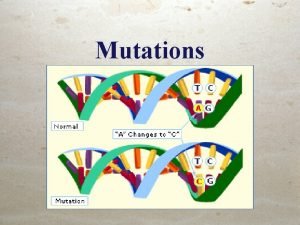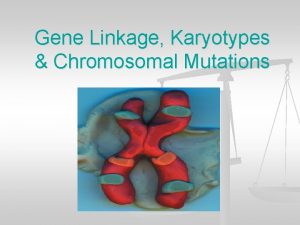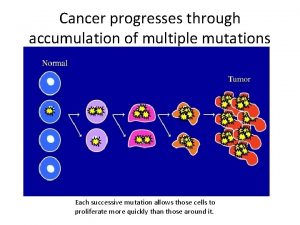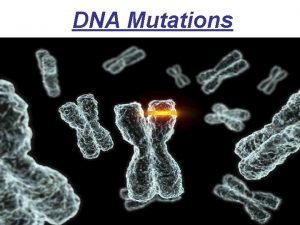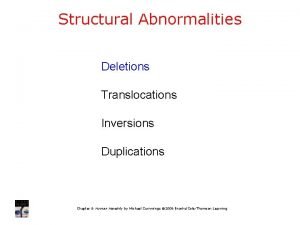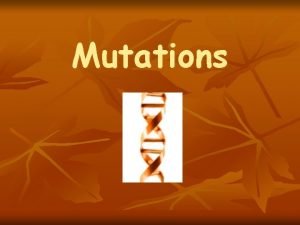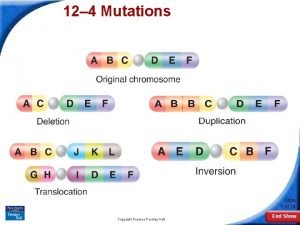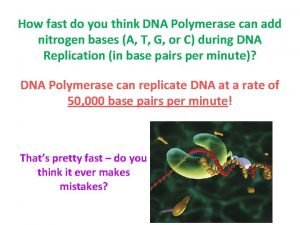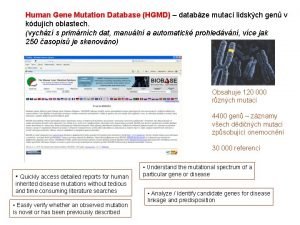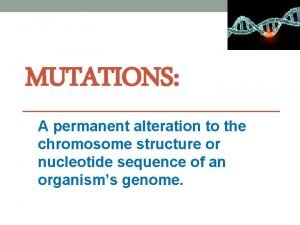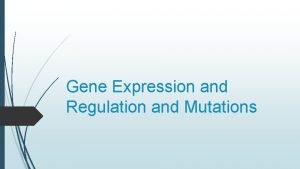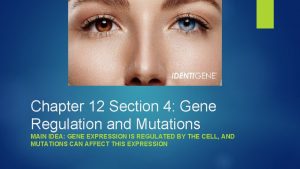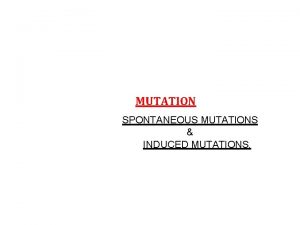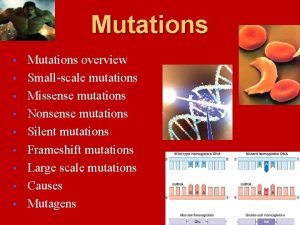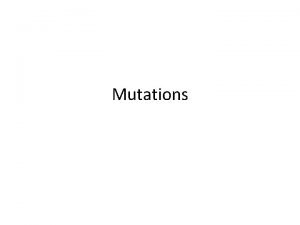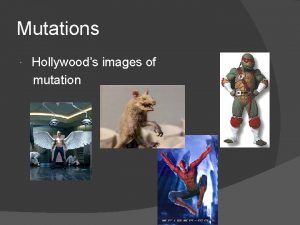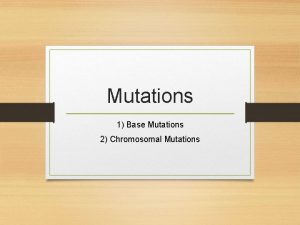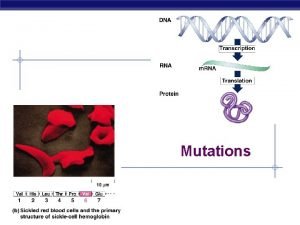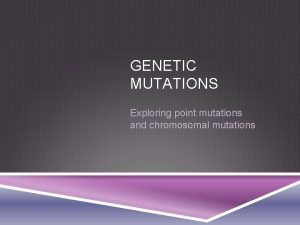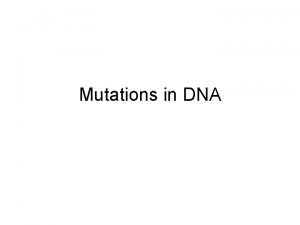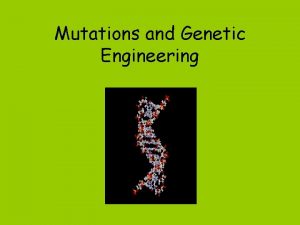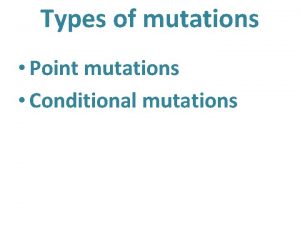Mutations What is a mutation A mutation is













- Slides: 13

Mutations What is a mutation? A mutation is any change in the DNA that changes the structure of a gene or the structure of the chromosome. ***Mutations may or may not affect the phenotype of the organism. REMEMBER: Like words in a sentence, the DNA base sequence of a gene determines the amino acid sequence of a protein it encodes. DNA base sequences are interpreted in groups of 3 bases called CODONS. When a base of a DNA codon is changed (a mutation occurs), then the codon changes which may change the amino acid sequence of the protein.

THE IMPORTANCE OF MUTATIONS: Mutations increase genetic variation within a species. They facilitate Biodiversity (variations in organisms) and Evolution (change of a species) by allowing a species to adapt to be better suited for their environment.

MUTATIONS : THE GOOD AND THE BAD EXAMPLES: *gene that makes bacteria resistant to an antibiotic (note: good for bacteria not good for humans) *gene in humans that produces an enzyme to metabolize cow milk lactose Camouflage gene EXAMPLES: *green eyes *color blindness *chin dimples EXAMPLES: *genes that increase cancer risks *being born with extra fingers or without arms or legs or Albino gene

Mutations usually occur during DNA Replication. Mutations can happen Spontaneously or by External Induced factors. Mutagens are external factors that cause mutations. Mutagens include:

2 Categories of Mutations • Chromosome mutations Mutations that affect large regions of DNA that is contained within chromosomes • Gene mutations Mutations that affect small regions of DNA, usually one base

TYPES OF CHROMOSOME MUTATIONS Chromosome Deletion Chromosome Duplication (Loss of part of the chromosome) (segment of chromosome is repeated) Chromosome Inversion (chromosome segment is in reverse order) Chromosome Translocation (part of chromosome breaks off and attaches to another chromosome)

--Chromosome Mutation Down Syndrome Karyotype (XY +21) Klinefelter Syndrome Karyotype (XXY)

GENE MUTATIONS mutated base

TYPES OF GENE MUTATIONS DEFINITION DNA STRAND EXAMPLE (O=original) (M=mutated) SUBSTITUTION Point Mutation One base is replaced with another base O: G G T A C T M: G A T A C T DELETION Point Mutation One base is removed O: G G T A C T M: G G T A T INSERTION (Addition) Point Mutation One base is added O: G G T A C T M: G G T A C G T INVERSION Mutation The order of two or more bases are reversed O: G G T A C T M: G A T G C T TRANSLOCATION Mutation The movement of one or more O: G G T A C T -- C G T C bases to another location on M: G G C T -- C G T A T C the DNA strand

MUTATION EFFECTS THAT RESULT FROM GENE MUTATIONS Frameshift mutation: results into a different amino acid sequence Missense mutation: results into one different amino acid Nonsense mutation: results into a codon that codes for STOP Silent mutation: results into a different codon that codes the same amino acid His same protein results

Sickle cell mutation Sickle cell disease (also called sickle cell anemia) is an inherited disorder caused by a gene mutation which codes for a malfunctioning Hemoglobin protein. The substitution of one base in the 438 bases causes an amino acid change, resulting in a slightly different version of the protein being produced. This leads to sickle shaped red blood cells that are unable to carry oxygen properly.

Problems Use this m. RNA codon chart and the information in this Power. Point (specifically frames #9 and # 10 - Types of Gene mutations and Mutation Effects) to answer the problems on the Mutation Worksheet that follows. You will have questions on Google Classroom that refer to the worksheet.

MUTATION WORKSHEET Original DNA Sequence: T A C C T T G G C G A C T m. RNA sequence transcribed codons: AUG Amino Acid Protein Sequence translated: (use Codon Chart ) (abbreviate) Met MUTATED DNA # 1 UGG AAC CGC UGC Trp Asn Arg Cys UGA STOP T A C A T C T T G G C G A C T m. RNA sequence transcribed codons: Amino Acid Protein Sequence translated : (use Codon Chart) (abbreviate) MUTATED DNA # 2 T A C G A C C T T G G C G A C T m. RNA sequence transcribed codons: Amino Acid Protein Sequence translated : (use Codon Chart) (abbreviate) MUTATED DNA # 3 m. RNA sequence transcribed codons: Amino Acid Protein Sequence translated : (use Codon Chart) (abbreviate) T A C C T T A G C G A C T
 A mutation is any mistake or change in the
A mutation is any mistake or change in the Karyotype mutations
Karyotype mutations Cancer mutations
Cancer mutations Chapter 14 lesson 4 mutations
Chapter 14 lesson 4 mutations 4 types of mutations
4 types of mutations Translocation mutation
Translocation mutation What is a helpful mutation
What is a helpful mutation 12-4 mutations
12-4 mutations What are some neutral mutations
What are some neutral mutations Gene mutations
Gene mutations Permanent alteration
Permanent alteration Chromosomal mutation
Chromosomal mutation Cancer mutations
Cancer mutations Chapter 12 section 4: gene regulation and mutations
Chapter 12 section 4: gene regulation and mutations
